How to grow Kalanchoe at home - step by step instructions
Kalanchoe attracts attention with its unusual beauty, bright inflorescences. In addition, the plant has medicinal properties. The time spent on care pays off with the aesthetic pleasure that everyone experiences when contemplating a blooming dwarf shrub. How to grow Kalanchoe at home, about the features of care and choosing a variety for growing will be discussed in the article.
Choosing a Kalanchoe variety for growing at home
As soon as the people do not call Kalanchoe: both a room doctor, and a tree of life, and an analogue of ginseng. The beneficial properties of the plant have long been used in alternative medicine. However, flower growers primarily value the aesthetics of the flower, which brings freshness and the spirit of nature to the interior.
In total, there are more than 200 species of Kalanchoe. Representatives of tolstyanka in natural conditions stretch up to 4 m. But there are also undersized varieties (15-20 cm), which bloom beautifully with hats or cute bells.
Table 1. Kalanchoe varieties.
|
Kalanchoe name |
Features of the variety |
|
Bekharskoe |
The homeland is the south of Madagascar. The leaves of the shrub are large, on the surface there is a gray felt covering. Small yellow inflorescences are formed at the tops of the shoots. |
|
Blossfeld |
The variety is distinguished by abundant flowering. Flowers are collected in umbellate inflorescences, predominantly red. The leaf is fleshy with a beautiful gloss. |
|
Kalandiva |
Beautiful and long-lasting flowering. Inflorescences come in a wide variety of colors. The peculiarity of the variety is the doubleness of the flowers. |
|
Felted |
The leaves of a semi-shrub are silvery-green in color with a brownish frame around the edges. Loose inflorescences are tubular. The variety is popularly called "cat ears". |
|
Marble |
The mountainous regions of Ethiopia are considered the homeland of the variety. White inflorescences are collected in umbrellas, greenish-brown leaves are covered with large stripes, jagged framing along the edges. |
|
Mangina |
The plant belongs to the ampelous species. Leaves are purple with green. Inflorescences are pinkish-orange, bell-shaped. Suitable for hanging baskets. |
What are the medicinal
Almost all varieties of exotic plants have healing qualities to one degree or another. However, the greatest effect when used in folk medicine is provided by the varieties: degremona and feathery Kalanchoe.
Degremona
A common variety that is incredibly popular with flower growers. In the wild, culture grows in Madagascar. In the wild, the height of the plant is 1.7-2 m. In indoor conditions, the stem stretches up to 50 cm. The leaves have small specks and stripes, the color is gray or greenish. The pink or purple inflorescences are large.
Cirrus
The plant in indoor conditions grows up to 1 m in height. In the wild, the stem stretches 1.5-2 times higher. On a powerful base, oval leaves are held, which are framed at the edges with denticles. Inflorescences are large, tubular. Their length reaches 20-25cm. Outwardly, the flowers look like bells.
Necessary conditions for growing Kalanchoe
Florists are enthusiastic about Kalanchoe. This flower, which evokes a lot of positive emotions, in return practically does not require anything special. It does not need to be fed frequently, transplanted and complex treatments performed.We can say that the plant gives more than it requires in terms of care.
And yet, when growing Kalanchoe, you should adhere to the following rules of agricultural technology.
Temperature
In spring and summer, the flower tolerates room temperature well. In extreme heat, they find a place on the terrace or balcony. In winter, a period of dormancy begins. The ideal regime for the culture is considered to be an air temperature within 6-8 °.
Reference! To stimulate budding, it is recommended to create a temperature difference for the plant between night and day values within 5-7 °.
Humidity
When growing Kalanchoe in an apartment, spraying can be omitted. In winter, this procedure negatively affects the plant, provoking the development of pathogenic microflora. To clean the leaves of dust, it is enough to periodically arrange a shower for the flower. In the cold season, flower growers manage by wiping the foliage with a damp cloth.
Wet wiping the leaves is part of a comprehensive parasite defense. Thanks to this care, damage to the plant by spider mites or mealybugs is prevented.
Lighting
Kalanchoe loves bright, but diffused light. Avoid direct sunlight. If necessary, the plant is protected from scorching rays by installing a shading structure (for example, a frame with tulle). If you plan to arrange flowers on the windowsill, it is recommended to choose windows from the west or east side.
Decorative varieties require additional lighting in the cold season. Without this, lush flowering is impossible. In the area of arrangement of flower pots, phyto lamps are installed (can be replaced with fluorescent ones). The lack of light inhibits the growth and development of the Kalanchoe.
Reference! Daylight hours should correspond to 10-12 hours.
Watering, feeding
The plant needs rare but abundant watering. The usual regimen is 3 times a month. In the hot season, the regularity is increased to 1 p. in Week. In winter, Kalanchoe is practically not watered. During the rest period, it is kept in a semi-dry state.
Due to waterlogging, the Kalanchoe often dies. Therefore, you should not irrigate the flower every day, even if there is unbearable heat outside.
The plant should be fertilized during the period of growth and flowering. For this purpose, mineral remedies intended for succulents are suitable.
Growing instructions at home
It is quite possible to grow a Kalanchoe without experience in floriculture, if you adhere to the general rules for caring for the plant.
Training
The soil for sowing Kalanchoe should be loose and light. You can use a ready-made substrate for cacti and succulents, or prepare the mixture yourself. To do this, you need to connect the following components:
- leaf humus (200 g);
- fertile land (200 g);
- coarse sand (300 g);
- charcoal (100 g).
You can add some broken red brick. They are used to fill the pot first to create drainage.
Reference! The soil for Kalanchoe should have an acidity in the range of 5.0-6.5 pH.
For sowing seeds, both a pot and a box are suitable. The main thing is that the container is made of natural material (ceramics, wood, clay, etc.). Dimensions do not play much of a difference, except that you should not take a very deep container. A height of 10-15 cm will be enough.
It is better to buy seeds in specialized stores. They, as a rule, have already been processed and do not require additional training. When self-collecting seed, it is recommended to disinfect it in a weak solution of potassium permanganate. After drying, the seeds will be ready for planting work.
For germination, a corner is selected in a room with good illumination and a stable temperature regime of about 20 °.
Planting instructions
Sowing is planned for mid-spring. The process is performed in this order:
- the pot or box is filled with broken brick and substrate;
- moisten the soil with warm water using a spray bottle;
- give a couple of hours to settle;
- seeds are laid out on the surface of the soil, slightly immersed in it with a finger;
- if necessary, sprinkle the landing with earth;
- cover the container with transparent polyethylene or glass;
- put in a sunny place.
The crops are periodically moistened by spraying and ventilated. For this, the shelter is removed for 15 minutes in the evening. As soon as green sprouts appear on the surface, the glass is removed.
When the seedlings reach the age of one month, a pick is carried out. By this time, 2 leaves have already been formed on the shoots. The transplant is done in small pots. Sometimes flower growers transfer 2 seedlings into one container. This will make the plant look more luxuriant.
After 2-4 weeks, the top of the young Kalanchoe is pinched to form a bush.
Further care
At the age of the plant 2-3 months, the care changes slightly. It's time to transplant into a more spacious flowerpot. By the transfer method, the young shoot is transferred to another container. This should be done carefully so as not to damage the delicate root system. After moistening, the flower is placed on the windowsill.
At this age, you can make top dressing. It is recommended to use mineral formulations. The first flowering can be enjoyed only after a year.
Watering regime - 1 time in 10-14 days. The amount of water should be sufficient to uniformly moisturize the substrate. It is important to avoid stagnation so as not to provoke root decay.
In the process of recruiting growth, the Kalanchoe needs ventilation (in the absence of drafts) and good lighting. As the lateral shoots are formed, excess shoots and pedicels are trimmed (after the end of the flowering period).
Protection against diseases and pests
Kalanchoe rarely gets sick with proper care. Daily monitoring of the condition of the flower will help to avoid problems. Thanks to this, it is possible to identify parasites or a pathological process at an early stage, which will make it possible to save the plant.
Table 2. Common diseases of representatives of the bastard family, as well as methods of dealing with them.
|
Protection against diseases and pests |
|||
|
The essence of the problem |
Causes |
Signs |
Control methods |
|
Late blight rot |
|
|
|
|
Powdery mildew |
|
|
|
|
Gray rot |
|
|
|
|
Aphids (small green insects) |
|
|
|
|
Shield |
|
|
|
If a disease or parasite is detected, the plant must be quarantined to avoid contamination of other flowers. Correct treatment leads to a rapid recovery of the Kalanchoe.
Transfer
The flower usually develops quickly. Intensive growth of the root system requires periodic replanting. It is better to plan these events for the second half of spring, when the activation of biological processes is noted.
You should start by moistening the soil. This will allow you to easily remove the roots from the flowerpot. It is not necessary to clean them from the ground; Kalanchoe is transferred to a new pot with an earthen lump.
The new container should be 2-4 cm larger in diameter than the old one (approximate parameters of the diameter are 12-15 cm). Do not choose a container that is too large.The composition of the soil mixture is used the same to accelerate the adaptation period.
Reference! The Kalanchoe pot should preferably be made of clay or ceramic.
After transplanting, the plant is moistened. After a couple of hours (until the earth is dry), top dressing is introduced. This will give the flower strength, help neutralize stress as much as possible. The adaptation usually lasts one week.
In winter it is also possible Kalanchoe transplant... For the plant to take root in a new pot, you need to create favorable conditions. During the operation of the heating system, this is more difficult to do.
Reproduction methods
Kalanchoe is ready to reproduce at the age of 1-1.5 years. Daylight hours should be at least 12 hours. If the day is shorter, use artificial lighting.
The main breeding methods:
- vegetative - using a cutting from a leaf or stem, rooting is carried out in water or a lightweight substrate (temperature regime - 18 ° at night, 20-21 ° during the day);
- seed - the material is sown in a container filled with soil mixture, before germination of seedlings I cover the container with glass (temperature regime - 20-21 °).
Necessary conditions for the growth of planting material:
- good lighting in diffused light;
- stable microclimate;
- low humidity level;
- daily airing.
Regardless of the type of reproduction, young shoots must be formed by pinching the tops of new layers.
Features of care during flowering
Flowering usually occurs once a year. Budding begins by the end of winter or in March. The main condition is the presence of a temperature difference between day and night indicators. The period lasts until mid or late spring. In the absence of buds, the plant is examined for the detection of diseases or insects.
Important points in caring for blooming Kalanchoe:
- rare but abundant irrigation;
- good lighting;
- introduction of top dressing (mineral fertilizers are used).
With proper care, you can enjoy blooming twice a year. The second time the flower can enter the budding phase by the end of June - mid-July.
How to grow a lush Kalanchoe
For flowering varieties of Kalanchoe, pruning is mandatory. The procedure is carried out radically. The peduncle is cut as low as possible. This is necessary to prevent decay of the remaining fragment.
Old shoots and shoots in poor condition are cut from the flower. In the summertime, the tops are pinched to stimulate the growth of the lateral branches. If this is not done, the Kalanchoe will be ugly stretched upwards. A lushly formed dwarf shrub looks much more attractive.
Reference! Young shoots removed from the flower can be used as rooting cuttings.
Tips on the topic
Experienced growers who have been growing Kalanchoe for more than one year are always happy to share interesting observations and practical advice. By taking them into account, many mistakes can be avoided.
- It is recommended to use lightweight soil with the addition of sand (at least ¼ part of the total volume) as a substrate.
- From the beginning of autumn until late spring, flower growers are not advised to spray the leaves. It is advisable to carry out such a procedure only in extreme heat.
- As the daylight hours decrease, it becomes necessary to use a backlight. With a lack of lighting, the shoots are strongly stretched, which spoils the appearance of the flower.
- You should not get carried away with top dressing. With an excess of mineral salts, the plant withers.
- Kalanchoe needs a rest period. If it is not organized, the decorative qualities of the flower are lost. Often, a culture reacts to a violation of the rest regime by dropping foliage.
- The crop needs pruning. The procedure rejuvenates the bush, promotes its shaping. You also need to pinch the tops.
Despite the unpretentiousness of the Kalanchoe, there are points to which you need to pay attention. The plant will thank for the reverent care with lush flowering, causing aesthetic pleasure.
Video instruction for caring for a flower at home:




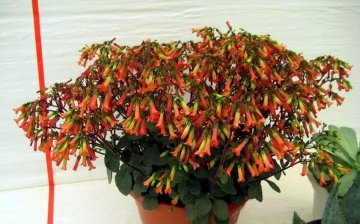
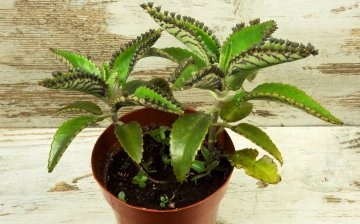



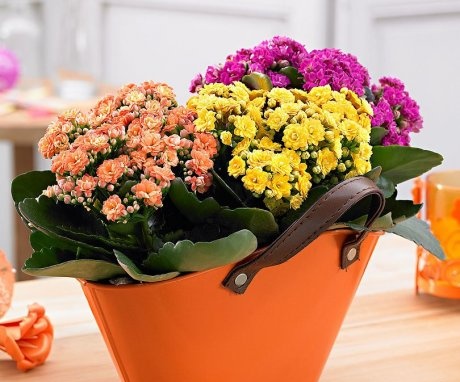
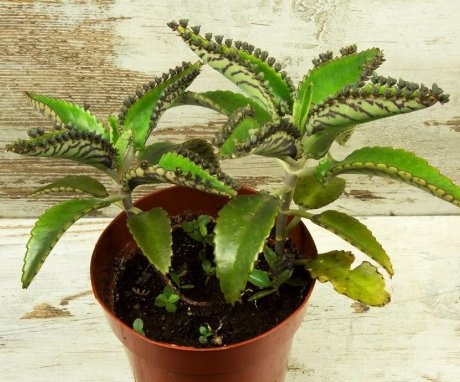
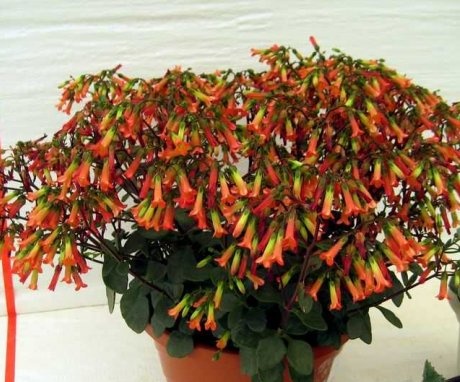
In fact, it is not so difficult to grow and care for the Kalanchoe. It's harder to make it bloom. I did everything as written, in the end, not a flower. Scored, and six months later blossomed in all its glory. True, she threatened to throw out these six months, maybe she was frightened.
I had Kalanchoe feathery. Unlike common scarlet, it is a more pernicious plant. I didn't bloom. He doesn't look very attractive either. Maybe someone uses it for medicinal purposes and does not look at beauty.
It turns out Kalanchoe is not that difficult to grow. Choose the correct soil composition in a pot, put the plant on a windowsill with good but diffused light and water no more than three times a month. I water the flower more often, it will need to be changed.
I have two Kalanchoe. After the purchase, they bloomed beautifully, thrived. But one of them got sick with something. After that, the disease spread to the second flower. It looks like powdery mildew. White dusty coating. I don't know how to deal with it. One had to be cut, it grows again. I am trying to cure the second one with drugs. Maybe someone came across?